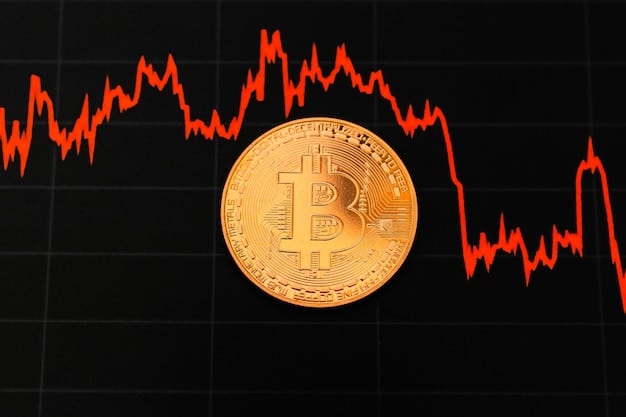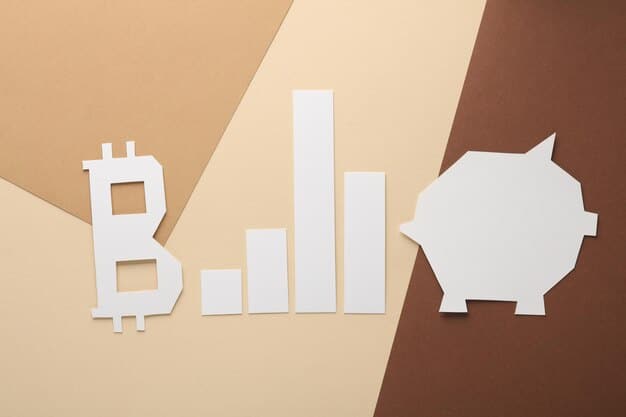Bitcoin and Inflation: A US Investor’s Guide to Hedging

Bitcoin’s potential as an inflation hedge for US investors is a complex issue, with arguments for and against its effectiveness based on its limited history, volatility, and correlation with other assets.
Is Bitcoin and Inflation: Is Bitcoin a Hedge Against Inflation for US Investors? This question is increasingly relevant for US investors seeking to protect their portfolios from the eroding effects of inflation.
Understanding Bitcoin and Inflation
Bitcoin, the pioneering cryptocurrency, has often been touted as a potential hedge against inflation. But what exactly is inflation, and how might Bitcoin theoretically counteract it? This section explores the basics before diving into the specifics of Bitcoin’s performance.
What is Inflation?
Inflation, in its simplest form, is the rate at which the general level of prices for goods and services is rising, and subsequently, purchasing power is falling. High inflation can erode the value of savings and make it more expensive to live.
How Bitcoin Could Act as a Hedge
Bitcoin’s appeal as an inflation hedge stems from its limited supply. Unlike fiat currencies, which central banks can print at will, there will only ever be 21 million Bitcoins. This scarcity, some argue, could make Bitcoin a store of value, similar to gold, that maintains its purchasing power during inflationary periods.
- Limited Supply: Only 21 million Bitcoins will ever exist.
- Decentralization: Not controlled by any central bank or government.
- Global Accessibility: Can be used and stored anywhere in the world.
In conclusion, understanding both the nature of inflation and the fundamental properties of Bitcoin is crucial before assessing its potential as an inflation hedge. While Bitcoin’s scarcity and decentralization are appealing, its actual performance during inflationary periods needs careful examination.

Bitcoin’s Performance During Inflationary Periods
To evaluate whether Bitcoin is truly an effective inflation hedge, it’s essential to examine its historical performance, particularly during periods when inflation has been on the rise. This section analyzes Bitcoin’s behavior in recent inflationary environments.
Bitcoin’s Recent History
Bitcoin’s history is relatively short, dating back to only 2009. As such, there are limited data to analyze its performance during prolonged inflationary periods. However, recent years have provided some insights.
Analyzing 2020-2023
The period from 2020 to 2023 saw significant inflation in the US, partly driven by pandemic-related stimulus measures and supply chain disruptions. During this time, Bitcoin experienced high volatility, with periods of both significant gains and losses.
- 2020-Early 2021: Bitcoin saw substantial price appreciation as inflation expectations grew.
- Mid-2021-2022: Despite rising inflation, Bitcoin’s price corrected sharply, influenced by macroeconomic factors and regulatory concerns.
- 2023 Onwards: Bitcoin began to recover, but its correlation with inflation remained uncertain.
In summary, while there were periods when Bitcoin appeared to move in tandem with inflation, its overall performance has been highly volatile and influenced by various factors beyond just inflationary pressures. This makes it difficult to definitively conclude that Bitcoin is a reliable inflation hedge based solely on its recent performance.
The Arguments for Bitcoin as an Inflation Hedge
Despite the mixed evidence from its historical performance, there are several compelling arguments in favor of Bitcoin as an inflation hedge. These arguments often center on its unique properties and potential future role in the global economy.
Scarcity and Limited Supply
As mentioned earlier, Bitcoin’s most appealing feature as an inflation hedge is its fixed supply of 21 million coins. This scarcity is hardcoded into its protocol and cannot be altered, making it inherently resistant to inflationary pressures caused by increased money supply.
Decentralization and Independence
Unlike traditional assets, Bitcoin is decentralized and not controlled by any government or financial institution. This independence can be particularly attractive during times of economic uncertainty when confidence in central banks and governments may be waning.

Potential for Increased Adoption
As Bitcoin gains wider acceptance and becomes more integrated into the global financial system, its value could potentially increase, further enhancing its ability to act as an inflation hedge. Increased adoption could also reduce its volatility over time.
In conclusion, the arguments for Bitcoin as an inflation hedge are strong and based on its unique characteristics. However, these arguments rely on the assumption that Bitcoin will maintain its scarcity, remain decentralized, and achieve widespread adoption.
The Arguments Against Bitcoin as an Inflation Hedge
Despite the potential benefits, there are also significant arguments against considering Bitcoin a reliable inflation hedge. These concerns often relate to its volatility, correlation with other assets, and regulatory uncertainties.
Volatility Concerns
Bitcoin’s price is notoriously volatile, experiencing large swings in short periods. This volatility makes it difficult for investors to rely on Bitcoin as a stable store of value during inflationary periods. A sudden price drop could offset any gains made as a result of rising inflation.
Correlation with Other Assets
Some studies have shown that Bitcoin’s price is correlated with other risk assets, such as stocks, particularly technology stocks. This correlation suggests that Bitcoin may not provide the diversification benefits typically associated with inflation hedges like gold or real estate.
Regulatory Uncertainties
The regulatory landscape for Bitcoin and other cryptocurrencies is still evolving. Regulatory changes, such as increased taxation or stricter enforcement, could negatively impact Bitcoin’s price and its ability to act as an inflation hedge.
In summary, the arguments against Bitcoin as an inflation hedge highlight the risks and uncertainties associated with this asset. Volatility, correlation with other assets, and regulatory concerns all pose challenges to Bitcoin’s effectiveness as a hedge against inflation.
Alternative Inflation Hedges for US Investors
Given the uncertainties surrounding Bitcoin’s ability to act as an inflation hedge, US investors may want to consider other asset classes that have a more established track record of protecting against inflation. These alternatives include traditional options like gold, real estate, and inflation-protected securities.
Gold
Gold has been a traditional store of value for centuries and is often used as a hedge against inflation. Its limited supply and historical performance make it a popular choice for investors seeking to preserve their wealth during inflationary periods.
Real Estate
Real estate can also serve as an inflation hedge, as property values and rental income tend to rise along with inflation. Investing in real estate can provide a stable income stream and potential capital appreciation during times of rising prices.
Treasury Inflation-Protected Securities (TIPS)
TIPS are government bonds that are indexed to inflation. Their principal value increases with inflation, providing investors with protection against the eroding effects of rising prices. TIPS are considered a safe and reliable way to hedge against inflation.
- Commodities: Certain commodities, like oil and agricultural products, can also act as inflation hedges.
- Inflation-Linked Bonds: Similar to TIPS, these bonds adjust their payouts based on inflation rates.
- Value Stocks: Companies with strong fundamentals and stable earnings can outperform during inflationary periods.
In conclusion, while Bitcoin may offer some potential as an inflation hedge, US investors should also consider traditional asset classes that have a proven track record of protecting against inflation. Diversifying across multiple asset classes can help mitigate risk and improve overall portfolio performance during inflationary periods.
Strategies for US Investors Considering Bitcoin as an Inflation Hedge
For US investors who are considering including Bitcoin in their portfolios as an inflation hedge, it’s essential to adopt a well-thought-out strategy that takes into account the risks and uncertainties associated with this asset. This section outlines some key strategies for managing Bitcoin investments.
Diversification
Diversification is a fundamental principle of investing. Investors should not put all their eggs in one basket but rather spread their investments across multiple asset classes to reduce risk. Bitcoin should be just one component of a diversified portfolio.
Dollar-Cost Averaging
Dollar-cost averaging involves investing a fixed amount of money in Bitcoin at regular intervals, regardless of the price. This strategy can help mitigate the impact of volatility and reduce the risk of buying at the peak.
Risk Management
Given Bitcoin’s volatility, it’s crucial to implement risk management strategies, such as setting stop-loss orders to limit potential losses. Investors should also be prepared to rebalance their portfolios periodically to maintain their desired asset allocation.
In summary, US investors considering Bitcoin as an inflation hedge should adopt a strategic approach that emphasizes diversification, dollar-cost averaging, and risk management. By carefully managing their Bitcoin investments, investors can potentially benefit from its upside potential while minimizing the downside risks.
| Key Point | Brief Description |
|---|---|
| 💰 Bitcoin vs. Inflation | Bitcoin’s potential as an inflation hedge is debated due to its volatility. |
| ⚖️ Arguments For & Against | Scarcity supports it, but volatility and correlation challenge its role. |
| 🛡️ Alternative Hedges | Gold, real estate, and TIPS offer more established inflation protection. |
| 📊 Investment Strategies | Diversification and dollar-cost averaging can manage Bitcoin’s risk. |
Frequently Asked Questions
▼
Bitcoin’s main appeal lies in its limited supply. With only 21 million coins ever to be produced, it’s seen as a store of value that can’t be easily devalued by inflation.
▼
Bitcoin is significantly more volatile than traditional hedges like gold or real estate. Its price can fluctuate dramatically in short periods, making it a riskier option.
▼
TIPS are government bonds that are indexed to inflation. Their principal value increases with inflation, providing investors with protection against the eroding effects of rising prices.
▼
Some studies suggest Bitcoin’s price is correlated with other risk assets, particularly technology stocks, which could limit its effectiveness as a portfolio diversifier.
▼
Strategies include diversification, investing a fixed amount regularly (dollar-cost averaging), and managing risk by setting stop-loss orders to limit potential losses.
Conclusion
In conclusion, the question of whether Bitcoin serves as an effective inflation hedge for US investors remains complex. While its scarcity and decentralization offer potential benefits, its volatility and correlation with other assets pose challenges. Investors should carefully consider their risk tolerance and investment goals before including Bitcoin in their portfolios, and they should explore alternative inflation hedges to diversify their holdings.





